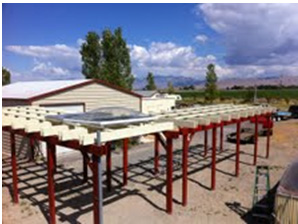Sep 20 2011
On October 1, SunScience Corporation (SSC) and the DoubleTree Ranch research facility in Lovelock, NV, will launch a Controlled-Environment Agriculture project using SSC’s Energy Management System (EMS) and Data Communications system (DCS) with Doubletree’s greenhouse faming operations.
The public is invited, including families, political leaders, the business community and other greenhouse farmers. Activities are scheduled 9AM to 3PM, Saturday, October 1 at the Doubletree Ranch, 1775 Loorz Rd, Lovelock. There will be balloon rides before 10:30 AM (weather permitting), food and drink and, of course, the unveiling of SSC’s solar energy system to dramatically extend the growing season for year around planting.

Traditional farming is at the mercy of the seasons, weather, availability of water, plant disease and persistence of pests. In northern climates farmers are confined to one harvest per year. Greenhouse farming has evolved to control many of these variables, but has remained a niche market, largely due to older technology, high construction and utility energy costs. Soil scientists tell us that of all the variables that affect a successful harvest, soil temperature is key and this is one of the variables that greenhouses are less able to control. The SunScience DG1 hybrid solar system will bringing soil temperature management to greenhouse planting, thereby extending the growing season.
Here are the benefits DoubleTree Ranch greenhouse operations can expect from SSC’s solar energy soil system, that will not add to their electric bill.
- A typical growing cycle, say 4-6 months, can be extended to 8-10 months.
- Killing frost is a reduced issue in a greenhouse powered by SunScience.
- Preliminary research suggests with optimum control of the growing environment, seed gestation periods and plant growth can be improved significantly, thereby increasing the number of plantings per year.
Benefits traditional farmers can expect by converting to greenhouse growing include:
- Farming will become possible in times in the year when weather is normally prohibitive.
- With control of humidity within the greenhouse, less evaporation occurs, therefore less water usage.
- And in a controlled greenhouse environment, pest and disease management is improved.
Here’s what DoubleTree owner John Shank had to say about why he is incorporating SSC’s soil heating solar system to his production "I have always been involved with alternative energy and from the beginning of my greenhouse project, I was going to incorporate the use of some type of geo-heating system. I had a design in place when I met SSC. SSC had two things to offer me. One was an understanding of what I was trying to do with geothermal heating and the use of off-grid electrical power. The second was the willingness to work with me to accomplish this at an affordable cost."
SSC’s Chief Science Officer James Parker, PhD, says "Heating air and soil, as well as freeze protection, require thermal energy use far exceeding electrical energy affordability in the greenhouse/hoophouse world. The SunScience system captures three to four times thermal energy over electrical energy - a perfect match for the greenhouse world."